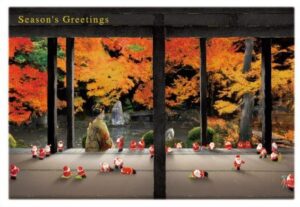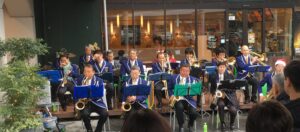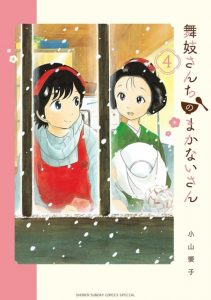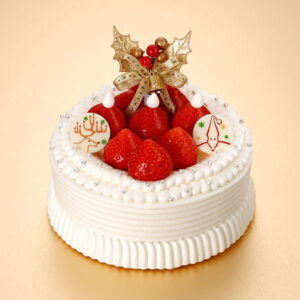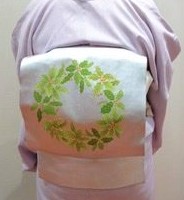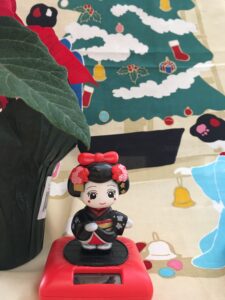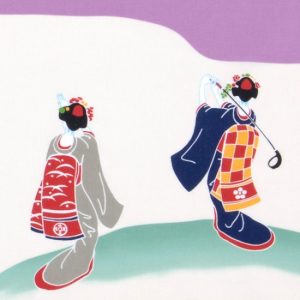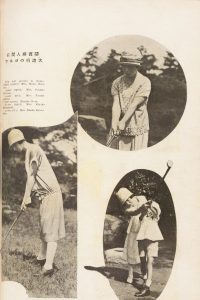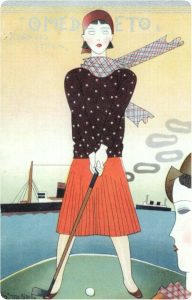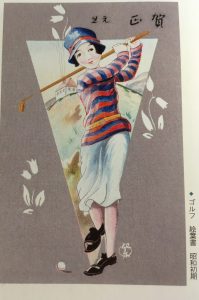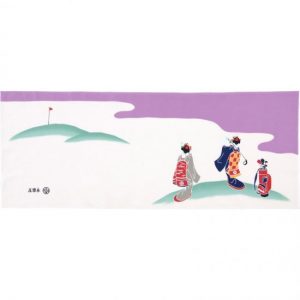True, Christmas is not an official event in the hanamachi. But in today’s post, we learn how playful maiko characters pop up in Christmas merrymaking. Even a former geiko’s ensemble nods to the holiday.
Making My Desk Maiko-Christmas Ready
Nothing like some cheery maiko to welcome December to my study.
I hang the “Maiko’s Christmas” tenugui from Eirakuya–shown above– across the wide computer screen. It’s an easy way to brighten up my desk for the holidays. Looking at this, you can almost forget December writing deadlines.
Displaying this delightful holiday card from Haruka sparks joy, too. Here, the maiko sits quietly at Renge-ji Temple. She gazes at its lovely garden. Tiny Santa Claus characters rambling around her seem comically misplaced. Merry mischief makers!
Christmas Decorations in Japan
Of course, I enjoy Christmas in Japan, too. Festive lights and special department store windows, prettily decorated Christmas cakes, and ornamented trees brighten the urban landscape in December. Spectacular light shows, known as winter illuminations, create fantasy spaces of LED lights, even in the Kyoto area. In 2018, Phil and I had great fun in Shizuoka City (near Mt. Fuji), hearing the brass band outside the train station belting out bouncy Christmas tunes, seeing Santa Claus-costumed dancers and Dixie Land band members in the shopping street, and attending a handbell-ringing concert by local high school girls.
Maiko and Geiko Join in Unofficial Christmas Fun
Christmas inspires hanamachi fiction, too. Koyama Aiko’s manga about superstar maiko Momohana and her cooking pal Kiyo “whip up” a sweet story.
The NHK-World Japan online anime “Kiyo in Kyoto: From the Maiko House” imagines maiko enjoying sugary delights in “Christmas in Kagai.” (Kagai is another pronunciation for hanamachi, the “flower districts” of teahouses and okiya).
As “Christmas in Kagai” opens, it’s nighttime. We see a giant lighted Christmas tree outdoors and illuminations. But when the view shifts to the hanamachi, the quiet streets look the same as ever. Only the usual hanamachi lanterns stand out. The narrator explains:
“There are no special Christmas events in kagai. No Christmas light decorations. And no Christmas trees. But there are hints of Christmas.”
The anime shows these jolly hints. One elderly teahouse okami-san (manager) wraps her obi with a bright red, green, and white obijime cord. Western-style flower arrangements in the room carry the Christmas theme. Clients bring gifts of brightly decorated Christmas cake, like the pretty 2021 confection shown here from Takashimaya.
Indeed, so many cakes arrive at Kiyo’s okiya that soon the maiko have had their fill of whipped cream and strawberries. Too busy practicing her dance, the diligent maiko Momohana has not had a single bite! Kiyo comes to the rescue, whipping up a tasty strawberry fruit sandwich for her pal. The “Christmas in Kagai” anime ends with a lesson in how to make fruit sandwiches, a maiko favorite.
An Elegant Geiko’s Christmas-themed Obi
“In Gion, the kimono is the indispensable heart of style,” writes former geiko Kiriki Chizu (226). As we see on her blog, Kiriki always turns an elegant figure in her tasteful kimono. Invoking Christmas gives an unusual seasonal dash to her ensemble.
In December, Kiriki sometimes posts photos of her chic yuletide obi. In 2017, she wrote about wearing it to Kabuki, “I wore my Christmas wreath obi. Kimono help you enjoy the feeling of the season, and that makes me happy.” This December, she paired the obi with a pale mauve kimono. In her book The Gion Way, Kiriki credits her sartorial flair to her okiya mother’s tutelage during her maiko days. She’d advise, “Doing the same thing as others is never stylish” (227).
Enjoy Seasonality, Feel Free to Invent
Thus, Kiriki learned to enjoy inventing her own creative moments within kimono conventions. Among these, the Christmas wreath most delights her. When a certain Kabuki actor’s wife, an aficionado of kimono, spotted her wearing the obi from afar, she rushed up to Kiriki. “Ooooh my, oh my, oh my…what is that?,” she asked with glee. With great satisfaction, Kiriki responded, “Oh, this? It’s Christmas.” Kiriki’s sole regret: she can only wear this chic obi in December (228).
Happy Holidays from Chapel Hill
Here’s to enjoying the year’s end in 2021 with your own ways of celebrating the season.
REFERENCES
Today’s featured image, the design “Maiko’s Christmas” is found at the website of Eirakuya, Kyoto’s famed textile firm, known for its tenugui (cloth hand towels).
https://eirakuya.shop-pro.jp/?pid=85952743
Kiriki Chizu. Aisare jōzu ni naru Gion-ryū: Onna migaki [The Gion way to skill in becoming loveable: A woman’s polish]. Tokyo: Kōdansha, 2007. For much more discussion of Kiriki’s book, see Maiko Masquerade: Crafting Geisha Girlhood in Japan, 2021. Translations here are mine.
Koyama Aiko. Maiko-san-chi-no Makanai-san. Serialized manga. Volume 17. Episode 23, Shōgakukan, 2017. NHK World Japan translates the manga title for its anime adaptation as Kiyo in Kyoto: From the Maiko House. Here, I reference anime Chapter 17: “Christmas in Kagai.” https://www3.nhk.or.jp/nhkworld/en/ondemand/video/2094006/
Jan Bardsley, “Merry Maiko Christmas,” https://janbardsley.web.unc.edu/ December 20, 2021.

